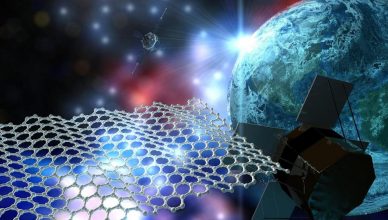Latest Posts

Experiments for Testing the Use of Graphene in Space-Related Applications
At the end of a long time spent working hard in the labs, this week, scientists from the Graphene Flagship are gearing up
[...]
The use of nanocomposites in vehicle parts and systems is expected to improve manufacturing speed, enhance environmental and thermal stability, promote recycling, and reduce weight. The use of nanocomposite-based parts provides stiffness, strength, and reliability comparable to or better than metals. They offer corrosion resistance, noise dampening, and enhanced modulus, thermal stability, and dimensional stability.
Nanotechnology also may hold the key to making space-flight more practical. Advances in nanomaterials could make lightweight spacecraft and a cable for the space elevator possible. By significantly reducing the amount of rocket fuel required, these advances could lower the cost of reaching orbit and traveling in space. Aerospace industry is, therefore, one of the foremost adopters of advanced composite materials, particularly composites reinforced with carbon fiber. On the other hand, the use of composite structures in both commercial and general aviation aircraft has been increasing primarily because of the advantages composites offer over metal (e.g. lower weight, better fatigue performance, corrosion resistance, tailorable mechanical properties, better design flexibility, lower assembly costs).
Nanotechnology also may hold the key to making space-flight more practical. Advances in nanomaterials could make lightweight spacecraft and a cable for the space elevator possible. By significantly reducing the amount of rocket fuel required, these advances could lower the cost of reaching orbit and traveling in space. Aerospace industry is, therefore, one of the foremost adopters of advanced composite materials, particularly composites reinforced with carbon fiber. On the other hand, the use of composite structures in both commercial and general aviation aircraft has been increasing primarily because of the advantages composites offer over metal (e.g. lower weight, better fatigue performance, corrosion resistance, tailorable mechanical properties, better design flexibility, lower assembly costs).
| Application | Product or article | Improved properties | Nanomaterials |
| Automotive | Car tyres Motorcycle helmets Automobile parts High-power rechargeable battery systems Thermoelectric materials Thin-film smart solar panels Fuel additives High-efficiency/low-cost sensors Glass Chassis materials Catalytic converters Nano-engineering of aluminium, steel, asphalt, concrete and other cementitious materials |
Higher strenght Easier to recycle Dimensional stability Noise dampening Higher thermal resistance Impact strength Flame retardant Stiffness Corrosion resistance Lower thermal distortion Barrier properties Higher durability Reduced weight Reduced fuel comsumption Easy rubber processing Low cost Higher flexibility Higher electrical conductivity Mechanical properties Thermal properties Water absorption Abrasion resistance Electrostatic discharge Higher tensile strength Electromagnetic interference Antifog Infrared light resistant Residue repellent Antireflective |
Nanoclays Carbon black Carbon nanofibers Carbon nanotubes Fullerenes Graphene |
| Aerospace | Construction materials Thermoelectric materials Fuel additives High-efficiency/low-cost sensors Glass Chassis materials Catalytic converters |
Lower weight Fatigue performance Strenght Toughness Reduced fuel comsumption Vehicle efficiency Corrosion resistance Tailorable mechanical properties Design flexibility Lower assembly costs |
Carbon fiber Carbon nanoubes Nanoclays Graphene Graphite fillers Iron fibers |





